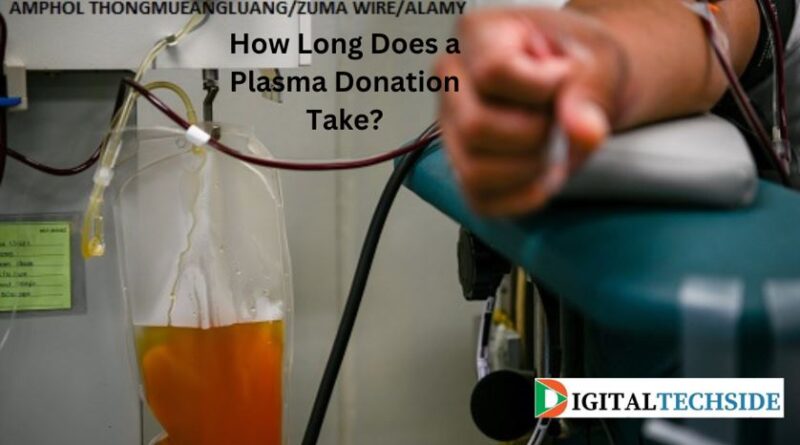How Long Does a Plasma Donation Take?
For first-time plasma donors or those considering donating, a common question is how long the plasma donation process takes from start to finish. In this article, we’ll provide an overview of the time commitment involved in providing a full plasma donation.
We’ll look at how long key steps like screening, donations, and post-care require. We’ll also discuss how duration may vary between first-time versus repeat visits. Understanding clearly how long plasma donations take is important for both planning your visits and maximizing your compensation.
Plasma Donation Overview
First, a quick overview of plasma and the donation process. Plasma is the yellow liquid portion of blood, making up about 55% of total blood volume. It contains proteins vital for regulating bleeding and immunity.
Donors receive compensation for each successful donation, and some programs, such as the biolife coupon $600 in three donations, provide additional incentives. Now let’s look at the time involved.
Plasma donation centers collect plasma from voluntary donors to provide the raw material for manufacturing therapies that treat a range of rare diseases. Qualified donors undergo automated plasmapheresis to separate and collect plasma for production.
Plasma Donation Process Steps
At certified plasma donation centers, the process involves four main steps:
- Donor eligibility screening
- The plasma donation itself
- Post-donation monitoring
- Donor compensation
The amount of time required for these four stages determines the total duration of a plasma donation visit.
Duration of Donor Screening
The first step in plasma donation is determining donor eligibility through screening:
- Registration check-in and ID verification
- Completing medical history questionnaires
- Listing medications and supplements taken
- Vital sign evaluation
- Staff review of responses
For first time donors, initial screening takes from 45-60 minutes to complete all documentation, questions, and evaluations.
For repeat donors, checking in and having vitals taken may only require 10-15 minutes as information is already on file.
Time for the Donation Itself
The actual plasma donation process via plasmapheresis involves:
- Getting weighed on a scale
- Reclining in the donation chair
- Disinfecting and accessing the arm
- Drawing and separating blood then collecting plasma
- Removing needles and bandaging the arm
This automated collection process itself typically takes only 45-60 minutes for first-time and repeat donors. Experienced donors may finish even faster.
Duration of Post-Donation Monitoring
After donating plasma, a short post-donation monitoring period follows:
- Moving to a refreshments area
- Hydrating and having a light snack
- Remaining in a resting state
- Being monitored for adverse reactions
- Receiving post-care instructions
Centers usually require 15-30 minutes of post-donation observation and care before donors can leave.
Time for Donor Compensation
The final step is providing donor compensation:
- Payment card funds loading by staff
- Card activation if first donation
- Review of compensation schedule
- Payment card receipt acknowledgement
Actual compensation issuance takes only a few minutes after each successful donation.
Total Duration of a Standard Plasma Donation
Taking into account the time required for this full sequence of screening, donating, monitoring and payment issuance, the total time commitment is:
- First donation: 1.5 to 2 hours
- Repeat donations: 1 to 1.5 hours
So while plasma donation requires an investment of time, the automated process is designed for efficiency. For the vast majority of donors, duration falls well within the above standard ranges.
What Can Lengthen the Plasma Donation Duration?
In some cases, certain factors may extend the total donation visit duration:
- Issues during screening requiring medical evaluation
- Difficulty accessing veins to collect plasma
- Adverse reactions requiring extended post-donation monitoring
- Long lines and staff availability at check-in
- Computer issues delaying data entry or compensation issuance
- Low plasma volumes requiring an extended collection period
While not the norm, these situations can occasionally prolong the duration of a visit. Yet even with atypical delays, most donations conclude within two hours.
How long does the first plasma donation take start to finish?
Generally 1.5 to 2 full hours for all steps – future donations are shorter.
Does a longer or shorter donation mean better compensation?
No – the amount paid is not tied directly to individual donation duration.
If I donate fast, can I leave early?
No, you must complete the mandated post-donation monitoring period regardless of lifeblood draw duration.
Does donating take longer over time as you age?
Not necessarily. Duration is most impacted by first-time vs. repeat factors, not age.
Conclusion
In summary, most plasma donations through certified centers take between 1 to 2 hours from check-in through post-donation monitoring and compensation issuance. Approximately 45-60 minutes is required for the donation itself, with additional time for screening, monitoring, and payment issuance. Repeat donors complete visits more quickly. Understanding the time commitment helps set expectations and plan accordingly around donating lifeblood. With an automated process designed for efficiency, plasma donations require relatively modest time that fits reasonably within most donors’ schedules.

As a DIGITALTECHSIDE author, the majority of our articles have been focused on technology, blogging, business, lifestyle, social media, web design and development, e-commerce, money, health, education, entertainment, SEO, travel, and sports.
Contact us at digitaltechside@gmail.com if you have questions of anything.




